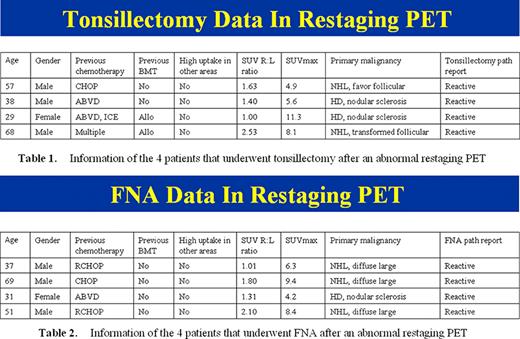Abstract
Abstract 3133
Significant tonsil uptake is sometimes observed in F-18 fluorodeoxyglucose (FDG) positron emission tomography (PET) after treatment. Some patients undergo tonsillectomy or FNA (fine needle aspiration) to rule out malignant involvement particularly when management depends on restaging (Figure 1). Our study describes the incidence and degree of tonsil FDG uptake in a large group of lymphoma patients that underwent PET scanning.
Restaging PET scan showing increased FDG tonsil uptake (red arrows) in a 38-year-old male patient with Hodgkin's disease stage II status post ABVD chemotherapy. Tonsillectomy was negative for malignancy.
Restaging PET scan showing increased FDG tonsil uptake (red arrows) in a 38-year-old male patient with Hodgkin's disease stage II status post ABVD chemotherapy. Tonsillectomy was negative for malignancy.
Single institution, retrospective chart review by ICD code, 617 lymphoma patients that underwent PET at our institution from 2004 to 2009. Results of PET were compared to pathological diagnosis of tonsillectomy (Table 1) or FNA biopsy (Table 2) when available which was performed at physician's discretion. Patients that were diagnosed with lymphoma during restaging studies performed for a different primary malignancy were excluded.
All 8 tonsillectomies and FNA biopsies performed after a restaging PET that showed increased tonsil uptake were negative for malignancy (Figure 2). All of these 8 patients had an initial previous PET that did not show increased tonsil uptake and also these 8 patients remained in remission from their lymphoma after the procedure was performed. In contrast, 6 out of 7 patients that underwent tonsillectomy or FNA at diagnosis were positive for malignancy (Table 3). Differences among tonsil FDG uptake has been thought to reflect differences in activity of “physiological” inflammation of the palatine tonsils. Increased glucose metabolism during active inflammation in the case of chronic tonsillitis or lymphocyte proliferation in the case of a patient that has received prior chemotherapy (likely experiencing compensatory extra medullar lymphoid hyperplasia) were thought to be causes of high FDG uptake in the tonsils. The significance of such increased tonsil FDG uptake is currently unknown however previous studies suggest that normal pharyngeal palatine tonsil uptake was generally symmetrical and that the difference in maximal standardized uptake value (SUVmax) between right and left tonsils (right-to-left ratio or a surrogate of symmetry) in the same patient might be helpful in detecting malignant tissue. The mean right-to-left ratio of tonsillar SUV was 4.55 in patients with confirmed malignant pathology and 1.53 in patients with documented benign tonsillar tissue (Table 4). The mean tonsillar SUVmax was 15.35 in patients with confirmed malignant pathology and 7.05 in patients with documented benign tonsillar tissue hence SUVmax seems to be useful in differentiating tumor from physiological accumulation. Younger patients with low SUV max symmetric tonsillar uptake and no other abnormal FDG areas seen during restaging PET could probably be watched non-invasively.
At the time of initial staging PET, increased tonsil uptake showed true lymphomatous involvement in most cases. At restaging, increased tonsil uptake displayed no cases positive for lymphomatous involvement as all tonsillectomies and FNA biopsies were negative for malignancy. These findings seem to be valid irrespective of the subtype of lymphoma. Our study supports a conservative non-invasive approach because physiologic uptake is the most common cause of increased tonsil uptake when restaging lymphoma patients after treatment has been completed.
No relevant conflicts of interest to declare.
Author notes
Asterisk with author names denotes non-ASH members.




This feature is available to Subscribers Only
Sign In or Create an Account Close Modal